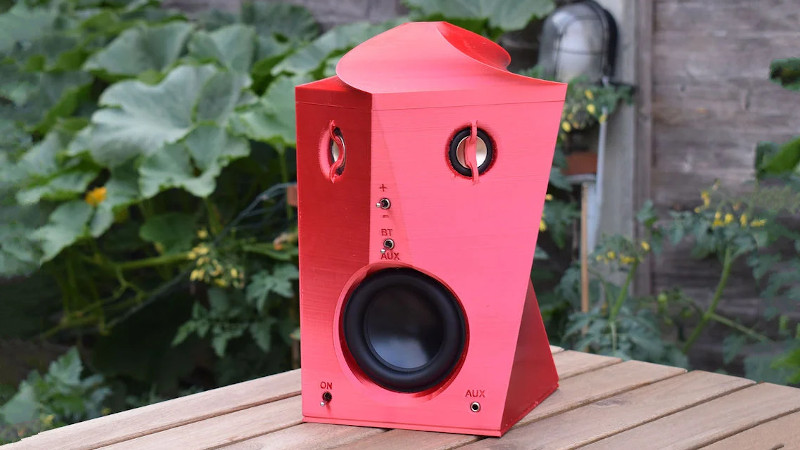Speaker design used to be as much about woodwork as it was about advanced acoustic mathematics. In recent decades, technologies such as digital signal processing and 3D printing have changed the game significantly. Leaning heavily on these techniques, [ssashton] developed a design called Mr. Speaker.
The speaker contains a 3″ woofer for good bass response, and twin tweeters to deliver stereo audio. Using WinISD to help do the requisite calculations on porting and volume, [ssashton] designed a swooping 3D printed enclosure with a striking design. Sound comes into the unit through an off-the-shelf Bluetooth module, before being passed to an ADAU1401 digital signal processing unit. From there, it’s passed to a mono amp to drive the woofer and a stereo one for the tweeters.
To get the flattest frequency response possible and maintain linear phase, it’s all about DSP in this case. RePhase software was used to design a DSP filter to achieve these goals, helping the speaker to produce the desired output. The ADAU1401 DSP was then programmed using Sigma Studio, which also allows the designer to do things such as split outputs for seperate woofer and tweeter drives.
[ssashton] does a great job of explaining both DSP principles and old-school speaker design tricks, from phase plugs to reflections. The use of 3D printed parts to rapidly iterate the design is impressive, too. We’d love to see the final enclsoure get an acetone smoothing treatment to really take it over the edge.
If you’re into serious speaker design and want more, be sure to check out this advanced transmission line design. For those of you with your own builds with some nifty tricks, drop us a note on the tipline.
















:o
It looks like a collaboration between Asmov and Picasso. I don’t know what this strange abstract robot head is looking at, but it surely looks horrified by what it sees.
Awesome description. Perhaps it’s looking at an Asimov/Dali robot?
Linear phase is not happening around the port frequencies and only at a single measurement point with the tweeters so far from the mid woofer. DSP is good though as can really sort out frequency response nonsense. If anyone wants a go for free on windows, check out EqualizerAPO
EqualizerAPO + PEACE gives you a nice interface.
I’ll go with… “If Edvard Munch had a cubist phase…”
Looking for his lost love Voder last seen at the 1939 worlds fair Bell Telephone exhibit. The horror of blurtooth 4.0 and what evil sounds come out of those eyes
I would really like to see a similar build but using the new design tools from the likes of TI “Smart Amp”. The new software allows you to model the speaker in great detail and the amplifier is allowed to overdrive it for short periods of time, taking into account the time it would take to overheat it. So a 5W speaker can deliver a 50W peak, and can also do some smart EQ to make them sound bigger than they are.
I have a small Sony BT speaker and the amount of bass the speaker puts out is ridiculous. I don’t know how it’s done and I haven’t seen anyone explore this avenue.
Missing fundamental effect/trick makes you hear the lower bass sound by shifting the signal up to its higher harmonics.
Not sure that’s the only thing. The speaker can make some pretty deep vibrations that go through tables/walls. Maybe it has a motor+weight inside, I haven’t opened it up (SRS-XB20). Maybe it’s some phasing trick that can cause the speaker port to output lower frequencies than the individual speakers.
What model is it? I’d like to try one.
It’s a sony srs-xb20. The trick only works at low volume (<50%), but it still pumps out a lot for a small room. But I've heard other similar speakers perform well above their size.
It’s incredible how far we’ve come in terms of audio tech and DSPs; consumer equipment now comes with a microphone input that let’s you calibrate your setup to your room…. AND YET, these would be still completely blown away by high-end speakers from 40 years ago such as big concentric Tannoy’s and similar beasts.
We are clearly doing something wrong.
Size. The market shifted away from giant speakers being the centerpiece of your living room audio system. This is all done just to eke better sound out of smaller speakers.
I imagine that the housing situation, at least across Europe, doesn’t help. Big living rooms are a luxury for most.
@Iván Stepaniuk said: “We are clearly doing something wrong.”
Nope, if the frequency and dynamic range/response is what you like and the perceived audio level is adequate for your listening purposes, the transducers and driver (speakers and amplifier) have nothing to do with it regardless of size, age, and technology. This is proven in the scientific discipline termed the psycho-acoustics of human sound perception.
Transconductance audio amplifiers. (i.e. Current mode audio amplifiers.) That’s what most are doing wrong… using voltage mode amplifiers.
I stumbled across the concept (again) in an article on EE Times based on a book that had been recently released. I experimented myself with it and have now been doing my own modifications to amplifiers. There are a few things that can get worse in the change, but they can be mitigated and the improvement in sound is phenomenal. I likely it to the change I heard when I first heard a CD after years of listening to cassette.
Oops, I meant to leave my comment as a reply to Iván Stepaniuk’s comment.